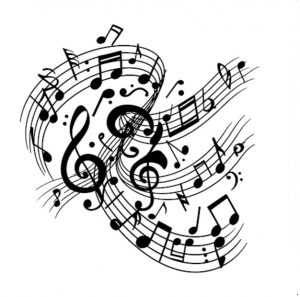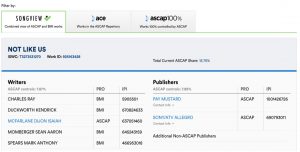Introduction
In this post, I will explore the nuances in music copyright law using Kendrick Lamar’s “Not Like Us” as a case study. This famous diss track should be well known either from the Superbowl Halftime Show, or from its major success at the Grammys. This famous song can help illustrate the complexity involved in music ownership and the copyright rights of music through public performance.
Copyright Basics
First, let’s go over what is copyrightable.
Copyright can exist in an original work of authorship with minimal creativity, fixed in a tangible medium, and if it is not barred. But what do these terms mean? Let me explain.
An original work of authorship means the author of the work independently created it. Minimal creativity, a low bar, simply requires the work to be more creative than a simple shape or a short phrase.
Fixed in a tangible medium means the work has to be in a sufficiently permanent or stable form so that it can be perceived. For example, a vague concept you have in your mind for a book plot would not be fixed in a tangible medium. However, if you wrote down some notes about the plot, that would be.
Finally, certain things are barred from being copyrighted. That list includes facts, ideas, methods, and works created by the federal government. Although these things are barred, an expression of a fact, idea, or method, could be copyrightable. For example, an idea for a cool song would not be copyrightable, but once that song is expressed in a tangible form and meets the other requirements, it can be copyrighted.
Who Has Copyright Rights? The Importance of Copyright Ownership
Understanding authorship is very important to understanding who has copyright rights. The author of the copyright is the default owner of copyrighted works. They have exclusive rights, called 106 rights, referring to the statute number in which they appear. These rights include the right to authorize reproduction, preparation of derivative works, distribution of copies, public performance, public display of the work, and public performance of sound recordings through digital audio transmission. 106 rights apply to all copyrighted works. Copyright infringement occurs when someone, without permission or exception, violates one of the six exclusive rights.
Who is the Copyright Author?
Determining who owns the work can be tricky when more than one person is involved in creating the work.
For example, joint authorship of a work exists when two or more authors intend to be co-authors and merge their separate contributions into a single work, provided the work meets the requirements set out above. Joint authors have an undivided interest in the copyrighted work, meaning they can each have the rights discussed above. They can also independently license to others without consent.
What are the Key Rights for Music?

While there are many nuances in copyright law, this post focuses on the 106 rights most relevant for music. There are two primary components to be considered: the sound recording (the actual recording of the song that you hear when it plays on the radio or on a streaming service) and the musical composition (the arrangement, notes, and melody of the written music for a song).
Sound Recordings and Musical Compositions
A public performance in copyright law is when a copyrighted work is performed or shown to the public either in person or through a transmission.
For sound recordings, the 106 public performance right is limited to digital audio transmission. This does not include CD or traditional radio, but it does include streaming services such as Spotify.
That means a cover song, which is an independent recording of a pre-existing song, does not infringe the original sound recording copyright because it doesn’t use the actual sounds fixed in the copyrighted song. However, it does use the underlying musical composition, so licensing is required, even for public or commercial use.
The musical composition, which includes the lyrics, melody, and arrangement embodied in sheet music, is protected by several 106 rights, including rights to reproduction and public performance.
For example, playing a CD in a restaurant would implicate the 106 public performance right of a musical composition. Likewise, without a license, a cover version of a song performed in public, even with different instruments, may violate the copyright if the melody and lyrics are sufficiently similar to the original.
Copyright in “Not Like Us”
Now, let’s apply those copyright concepts to a real-life scenario: “Not Like Us” by Kendrick Lamar. First, we know this song is copyrightable because it is an original work by Kendrick – certainly a very creative way to throw shade at Drake. It’s fixed in a tangible medium (e.g., available for streaming). And it’s not barred from copyrightability (not just an idea, fact, or method).
The next step is to figure out who owns the rights to this song. As noted before, the default owner of copyright is the copyright “author.” This can be tricky because there are different components, from the lyrics to the beat, that involve production and recording. Ownership may be split between those who created the musical composition and who contributed to the sound recording.
On the Universal Music Publishing Group (UMPG) website, Kendrick Lamar, Ray Charles, Dijon McFarlane (“Mustard”), Sean Momberger, and Mark Spears (“Sounwave”) are listed as the writers of “Not Like Us.” Ray Charles’ “I Believe to my Soul” is sampled in “Not Like Us,” which is why he is credited as a songwriter. Mustard, Sean Momberger, and Sounwave are all producers, meaning they oversee and direct recording projects for artists.
If Kendrick Lamar wrote the lyrics entirely on his own as asserted in this New York Times Article, then he would be the sole author and owner of the copyright over the song lyrics. If Kendrick co-wrote this song with the other listed writers – excluding Ray Charles because he was not involved in the writing process – then there is a potential for joint authorship among the co-writers. If so, that would mean each writer would have the right to license the copyright of the lyrics without the other’s permission, subject to an obligation to account for profits.
The master recording, the official, original recording of a song, was likely a collaboration between Kendrick Lamar and the producers mentioned above. If they intended to be joint authors and each contributed original, copyrightable elements to the recording, then they would be considered joint authors of the sound recording. But, it seems questionable whether the producers actually did create copyrightable elements if they only gave verbal directions and were not part of the actual sound recording.
Complexities of Copyright Licensing
If someone wanted to perform “Not Like Us” onstage in public without permission, they would be infringing on the musical composition right to perform the song publicly. If someone wanted to play the copyrighted sound recording of “Not Like Us” on a streaming service at their bar or restaurant, they would be infringing the copyright of the sound recording without a public performance license.
The reality behind copyright ownership for music is even more complicated due to licensing and royalties. The author of a song can license their work to another entity, which allows that entity to use the copyrighted work, which allows them to avoid infringement. Broad licenses can be purchased that allow businesses and venues to play copyrighted music from multiple authors so that there is no need to seek an individual license to play each song.
The three main companies that deal in these licenses are Broadcast Music Inc. (BMI), American Society of Composers, Authors, and Publishers (ASCAP), and The Society of European Stage Authors and Composers (SESAC).

These companies are known as Performing Rights Organizations (PROs) and they collect the income on behalf of songwriters and publishers when a song is publicly performed or broadcasted. Venues, radio stations, and businesses can purchase licenses from PROs that allow them to play copyrighted sound recordings, or publicly perform copyrighted musical compositions, without risk of an infringement suit.
If a venue wanted to play “Not Like Us” they would need a license from the PRO that represents the songwriters and publishers. ASCAP only represents one of the writers (Mustard), and two of the producers, while BMI represents the rest of the writers on the song. Therefore, licenses from both may be necessary.
Conclusion
The copyrights that exist in musical works involve a lot of moving parts and can easily be confusing, as exemplified in “Not Like Us.” Copyrightability, authorship, and the differences between sound recordings and musical compositions all weigh on who has what kinds of rights.
As such, it is important for people to be aware of these nuances in order to avoid the mistake of infringing and dealing with a resulting lawsuit. It is also important for musicians and artists to understand the breadth of rights they have, and options they have when it comes to licensing their works.

Lexi Shoup
Associate Blogger
Loyola University Chicago School of Law, J.D. 2026
